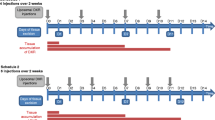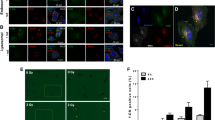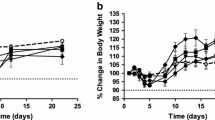Abstract
Purpose
To investigate the ability of systemically delivered BCNU to enhance the activity of either systemically delivered irinotecan (CPT-11) or locally delivered camptothecin from a biodegradable polymer for treatment of an intracranial 9L gliosarcoma.
Methods
We used a single systemic dose of BCNU on treatment day 1 in combination with systemic doses of CPT-11 on treatment days 1–5 and 8–12 against an intracranial rat 9L gliosarcoma model implanted into female Fischer 344 rats. We also used the same systemic dose of BCNU given on treatment day 1, followed by a local dose of a 20% loaded camptothecin biodegradable polymer implanted on the same day.
Results
Two doses of CPT-11 (10 and 60 mg/kg) were delivered systemically against intracranial 9L. Neither dose showed an increase in survival compared to controls (P>0.2 for 10 mg/kg and P=0.17 for 60 mg/kg). Systemic delivery of CPT-11 (10 mg/kg per day) in combination with systemic BCNU (15 mg/kg) did not show a significant effect on survival compared to systemic BCNU alone (P>0.2), even at the maximally tolerated systemic dose of CPT-11 (60 mg/kg per day; P=0.06). The combination of systemic BCNU (15 mg/kg) and intracranial delivery of camptothecin (20% loaded polymer), however, significantly extended survival compared to systemic BCNU alone (P<0.001) and compared to intracranial delivery of camptothecin alone (P=0.01).
Conclusions
In a 9L gliosarcoma model, systemic delivery of CPT-11 showed no benefit in survival when delivered alone or in combination with systemic BCNU, because CPT-11 is unable to cross the blood–brain barrier in cytotoxic levels. When cytotoxic levels of a topoisomerase I inhibitor are delivered directly to the brain tumor via a biodegradable polymer, however, the systemic delivery of the alkylating agent BCNU significantly enhances the antitumor effects of camptothecin in a 9L gliosarcoma model.



Similar content being viewed by others
References
Coggins CA, Elion GB, Houghton PJ, et al (1998) Enhancement of irinotecan (CPT-11) activity against central nervous system tumor xenografts by alkylating agents. Cancer Chemother Pharmacol 41:485–490
Nakatsu S, Kondo S, Kondo Y, et al (1997) Induction of apoptosis in multi-drug resistant (MDR) human glioblastoma cells by SN-38, a metabolite of the camptothecin derivative CPT-11. Cancer Chemother Pharmacol 39:417–423
Castellino RC, Elion GB, Keir ST, et al (2000) Schedule-dependent activity of irinotecan plus BCNU against malignant glioma xenografts. Cancer Chemother Pharmacol 45:345–349
Devore R III, Johnson D, Crawford J, Dimery I, Eckardt J, Eckhardt SG (1998) Irinotecan plus cisplatin in patients with advanced non-small-cell lung cancer. Oncology (Huntingt) 12:79–83
Enzinger PC, Ilson DH, Saltz LB, O’Reilly EM, Kelsen DP (1998) Irinotecan and cisplatin in upper gastrointestinal malignancies. Oncology (Huntingt) 12:110–113
Enzinger PC, Ilson DH (2000) Irinotecan in esophageal cancer. Oncology (Huntingt) 14:26–30
Goldberg RM, Erlichman C (1998) Irinotecan plus 5-FU and leucovorin in advanced colorectal cancer: North American trials. Oncology (Huntingt) 12:59–63
Green MR, Harper M, Safa A, et al (2000) Irinotecan in the management of patients with pancreatic cancer. Oncology (Huntingt) 14:31–33
O’Reilly EM, Ilson DH (2001) Cisplatin and irinotecan in upper gastrointestinal malignancies. Oncology (Huntingt) 15:42–45
Blaney SM, Takimoto C, Murry DJ, et al (1998) Plasma and cerebrospinal fluid pharmacokinetics of 9-aminocamptothecin (9-AC), irinotecan (CPT-11), and SN-38 in nonhuman primates. Cancer Chemother Pharmacol 41:464–468
Storm PB, Moriarity JL, Tyler B, Burger PC, Brem H, Weingart JD (2002) Polymer delivery of camptothecin against 9L gliosarcoma: release, distribution, and efficacy. J Neurooncol 56:209–217
Fassberg J, Stella VJ (1992) A kinetic and mechanistic study of the hydrolysis of camptothecin and some analogues. J Pharm Sci 81:676–684
Domb AJ, Langer R (1987) Polyanhydrides. I. Preparation of high molecular weight polymers. J Polym Sci 25:3373–3386
Brem H, Ewend MG, Piantadosi S, Greenhoot J, Burger PC, Sisti M (1995) The safety of interstitial chemotherapy with BCNU-loaded polymer followed by radiation therapy in the treatment of newly diagnosed malignant gliomas: phase I trial. J Neurooncol 26:111–123
Sipos EP, Tyler B, Piantadosi S, Burger PC, Brem H (1997) Optimizing interstitial delivery of BCNU from controlled release polymers for the treatment of brain tumors. Cancer Chemother Pharmacol 39:383–389
Valtonen S, Timonen U, Toivanen P, et al (1997) Interstitial chemotherapy with carmustine-loaded polymers for high-grade gliomas: a randomized double-blind study. Neurosurgery 41:44–48; discussion 48–49
Friedman HS, Petros WP, Friedman AH, et al (1999) Irinotecan therapy in adults with recurrent or progressive malignant glioma. J Clin Oncol 17:1516–1525
Bogaards JJ, Bertrand M, Jackson P, et al (2000) Determining the best animal model for human cytochrome P450 activities: a comparison of mouse, rat, rabbit, dog, micropig, monkey and man. Xenobiotica 30:1131–1152
Nakashio A, Fujita N, Rokudai S, Sato S, Tsuruo T (2000) Prevention of phosphatidylinositol 3′-kinase-Akt survival signaling pathway during topotecan-induced apoptosis. Cancer Res 60:5303–5309
Datta SR, Brunet A, Greenberg ME (1999) Cellular survival: a play in three Akts. Genes Dev 13:2905–2927
Yao R, Cooper GM (1995) Requirement for phosphatidylinositol-3 kinase in the prevention of apoptosis by nerve growth factor. Science 267:2003–2006
Chang HW, Aoki M, Fruman D, et al (1997) Transformation of chicken cells by the gene encoding the catalytic subunit of PI 3-kinase. Science 276:1848–1850
Acknowledgement
This work was funded in part by the National Institutes of Health, grant NCI CA 52857.
Author information
Authors and Affiliations
Corresponding author
Rights and permissions
About this article
Cite this article
Storm, P.B., Renard, V.M., Moriarity, J.L. et al. Systemic BCNU enhances the efficacy of local delivery of a topoisomerase I inhibitor against malignant glioma. Cancer Chemother Pharmacol 54, 361–367 (2004). https://doi.org/10.1007/s00280-004-0800-7
Received:
Accepted:
Published:
Issue Date:
DOI: https://doi.org/10.1007/s00280-004-0800-7




